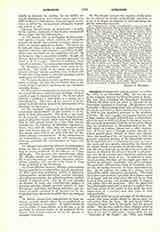

Schadow, FRIEDRICH WILHELM, painter, b. at Berlin, 1789; d. at Dusseldorf, 1862. He was the son of the sculptor, Johann Gottfried Schadow of Berlin. The year after Cornelius left Dusseldorf, Friedrich Wilhelm Schadow took his place as director of the Dusseldorf Academy of Painting. He had been with Cornelius at Rome among those who gathered around Overbeck, and while at Rome had become a Catholic. In 1819 he was appointed professor in the Academy of Berlin. He was a capable and popular teacher, and a large number of pupils followed him to Dusseldorf, where he went in 1826 and where he had great success. He was more in harmony with the artists of the Rhine than his predecessors at Dusseldorf had been. He laid stress on realism, color, and a sober moderation, all based upon a through technic, whereby his school gained many friends at home and abroad. After the founding of the Art Association in 1829 the graceful, animated pictures of the Dusseldorf school, which appealed either to Christian devotion or everyday taste, and were greatly admired by the friends of the school, found acceptance in all directions. Schadow did not at first take up the ideal fresco, as did the masters at Munich, but devoted himself to oil painting; nor did he attempt great historical subjects, but the more modest forms of art. In addition to devotional pictures, Schadow and his pupils gave their attention to portraits, landscape, and genre pictures. His principles differed from those of Cornelius, without his advancing, however, to those maintained today. In his opinion, the value of a picture rested upon form, color, and poetic conception. The pupil must first learn to draw, especially after plaster copies of antiques, and not until after this was he to learn to draw from nature, and to make studies of drapery and color after old paintings. After the pupil had been thoroughly grounded he was not to neglect drawing from nature or the model, at first under the strict supervision of a teacher, and then later to work independently.
Schadow held fast to the principle of the Romantic school, that more weight should be placed upon the conception than the form. He had much skill in arousing interest both in his pupils and the general public. For his own work he chose religious painting and some of his paintings of this kind fully meet the aims of art and of edification; among these are the “Ascension of the Virgin”, the “Wise and Foolish Virgins”. Other good pictures are “Christ on the Mount of Olives”, “Christ with the Disciples at Emmaus“, the “Pieta,”, the “Queen of Heaven“, the “Blessed Virgin as Intercessor”. Among his best creations also are: the “Four Evangelists”, and “Paradise”, “Purgatory“, and “Hell“. During his lifetime his portraits, for example those of brother artists, were greatly admired. It should, however, be remarked that Schadow, notwithstanding his study from nature, never fully overcame the weakness of the Romantic school, and although he was three times in Italy, where he studied the masters, he exhibited less original force than a graceful talent. Regularity and logic are natural to him rather than depth of content in the drawing and color. Immermann, at a later date, when he had abandoned Romanticism, judged harshly the characteristics impressed by Schadow upon the Dusseldorf school. These criticisms, however, generally overlook the fact that Schadow’s religious feeling, which remained as an inheritance to the Dusseldorf school, maintained the claims of art while meeting the justified demands of life and popular taste, and, finally, that the self-contained emphasis placed upon realism deserved the undoubted success it obtained. It was natural that in the course of time other elements also made themselves felt in the school, but these were only in part the signs of an advance. Schadow was also an author, although not one of preeminent importance. He laid down his opinions concerning training in art in several treatises and in a novel called “Der moderne Vasari” (Berlin, 1854). He resigned his position as director of the academy after thirty-three years’ service. His pupils were distinguished by the honorable positions they received. His portrait by Bendemann is in the Dusseldorf Academy.
G. GIETMANN

